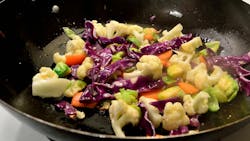From salad to smile: Cruciferous veggies may battle tooth decay
As though there weren’t already enough reasons to eat your vegetables (and 25% of the US population reports never having eaten a vegetable,1 but more on that later), you can now add this reason: cruciferous vegetables have the potential to reduce plaque buildup and therefore, reduce dental caries throughout the population.
It’s true! According to a research team at the Department of Biotechnology Engineering, Ben Gurion University of the Negev in Israel, that kale salad or serving of cauliflower could lead to a healthier mouth.2 Their studies demonstrate that diindolylmethane (DIM), also known as bisindole, the natural compound found in several cruciferous vegetables, holds promise for reducing biofilm.
Imagine telling your patients that eating broccoli or arugula could improve their oral health and help them avoid cavities. And as an added benefit for those patients who are concerned about such things: they would avoid any chemicals that might be included in their oral care products.
DIM shows powerful results against cavity-causing bacteria
The researchers are particularly hopeful about the vegetables’ potential for improving oral health in dental deserts and countries without easy access to dental care. Their laboratory tests have shown that DIM can destroy up to 90% of the biofilm formed by Streptococcus mutans, the culprit behind biofilm. In their tests, DIM disrupted S. mutans almost completely, preventing the bacteria from multiplying and sticking to teeth.2
Since it’s in vegetables, DIM is a natural product with a very low toxicity. Despite this, the researchers are aware that the possible systemic absorption of DIM should be minimized, and a target formulation should be developed for local application.
The report states: “Examination and characterization of the virulence properties expressed by S. mutans reveal how this characteristic may actually favor bacterial propagation and explain its ability to thrive in a place that many competing oral bacteria find lethal. S. mutans’ ability to tolerate this acidic milieu is considered a major virulence factor. Therefore, we tested the S. mutans survival rate after 2 and 4 h at pH 5.0 with and without DIM treatment. Treatment with 0.5 µM DIM decreased S. mutans viability significantly after 2 and 4 h, when compared to the control where bacterial viability did not change significantly. Thus, in an acidic environment similar to what is found in the oral cavity, fewer S. mutans bacteria survived in the presence of DIM.”3
In other words, S. mutans can thrive in environments where other bacteria cower.
It should be noted that DIM has been recognized in helping to treat several other medical conditions. DIM can reduce inflammation, help with symptoms of PMS and menopause, help prevent breast cancer, fight acne, and assist with weight loss.4
For the next steps in their DIM and oral health studies, the researchers will move their findings from the lab and begin tests on humans. “The prevention of the ability of S. mutans to produce EPS using this compound may help to change the environment for the development of caries, thus improving oral disease management for the whole population,”3 they state. They also stress that DIM would not replace oral health routines but supplement those routines and provide another level of protection.
Americans aren’t eating enough of these protective vegetables
Now, as promised, more on that survey about vegetable consumption (or lack thereof) in the US. While a quarter of the 2,000 respondents had not eaten a vegetable in their entire life, those who do eat vegetables include them in only one third of their meals.1 And cruciferous vegetables, the ones with DIM, were far from anyone’s favorite and regularly consumed vegetable. While corn and potatoes came in first and second as people’s favorite vegetables (not cruciferous) radishes and brussels sprouts (cruciferous) came in dead last.1
But not to worry. The list of vegetables that contain DIM is pretty lengthy so there are plenty of choices: broccoli, brussels sprouts, cabbage, cauliflower, arugula, collard greens, mustard greens, radish, and horseradish.
Feel free to tell your patients they might avoid some extra visits to the dentist if they eat their vegetables. Maybe even toss in a bit of guilt—the survey revealed that 72% of the respondents wished they ate more vegetables.1 Now you can give them another solid reason to.
Now, go fix yourself that kale salad!
References
1. Renner B. Stunning survey reveals quarter of Americans have never eaten a vegetable. Study Finds. July 1, 2024. https://studyfinds.org/stunning-survey-reveals-1-in-4-adults-has-never-eaten-vegetables/
2. Crotti S. Scientists discover a natural compound that destroys 90% of plaque-causing film—could transform dental care. Metabolic. September 15, 2025. https://okdiario.com/metabolic/en/health/scientists-discover-a-natural-compound-that-destroys-90-of-plaque-causing-film-could-transform-dental-care-19122/
3. Baruch Y, Golberg K, Sun Q, et al. 3,3′-Diindolylmethane (DIM): a potential therapeutic agent against cariogenic Streptococcus mutans biofilm. Antibiotics. June 6, 2023. https://www.mdpi.com/2079-6382/12/6/1017
4, Ellis RR. Health benefits of DIM (Diindolylmethane). WebMD. April 22, 2024. https://www.webmd.com/vitamins-and-supplements/health-benefits-dimhttps://www.webmd.com/vitamins-and-supplements/health-benefits-dim
About the Author

Meg Kaiser
Associate Editor
Meg Kaiser is an associate editor in Endeavor Business Media’s Dental Division. She works on DentistryIQ.com, RDH eVillage and RDH Graduate newsletters, Dental Economics magazine, and RDH magazine, and has for nearly 20 years. She knew she'd caught the dental bug when she began preaching oral-systemic health to everyone she met. Contact her at [email protected].
